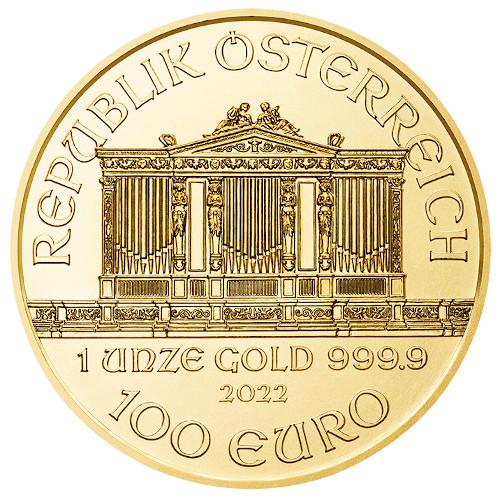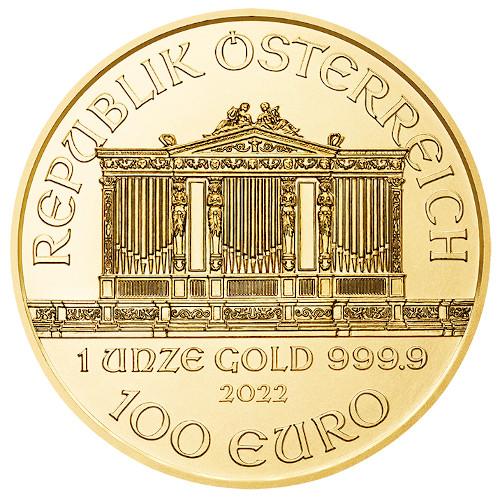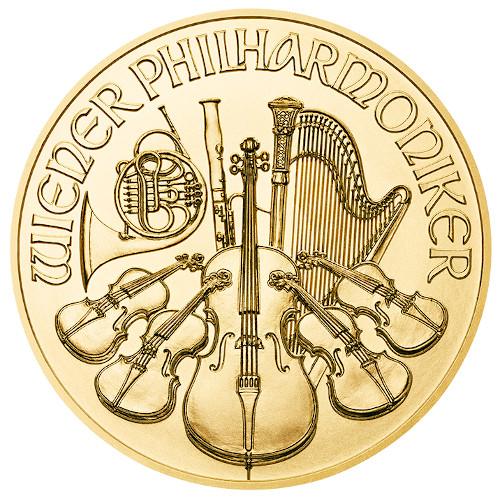Note: PreMeSec provides the metal value based on the market value of the precious metal for informational purposes only. PreMeSec.ch does not trade in precious metals itself. The price data is provided by third-party companies and updated several times an hour. PreMeSec.ch is not liable for the accuracy of the information and does not provide any trading or investment recommendations. Users of the trading platform are free to set their own prices; PreMeSec has no influence on these and accepts no liability.
Summary
- The Vienna Philharmonic is one of the most traded gold coins in the world.
- The Vienna Philharmonic is made of 999.9 parts gold.
- The Vienna Philharmonic is produced by the Austrian Mint.
- The Vienna Philharmonic originates from Austria and both its name and design are a reference to the orchestra of the same name.
- The Vienna Philharmonic is minted from gold in the sizes 1 ounce, ½ ounce, ¼ ounce, 1/10 ounce and 1/25 ounce.
- In silver, the Vienna Philharmonic is minted as a 1-ounce coin.
- The platinum version of the Vienna Philharmonic is available as a 1 ounce or a 1/25 ounce.
- The Vienna Philharmonic was the second modern European gold coin to be minted.
Introduction to the gold coin Vienna Philharmonic
The Vienna Philharmonic was introduced in 1989, when Europe's most successful bullion coin up to that time, the Krugerrand, was embargoed. As the name suggests, it comes from Vienna, the capital of Austria, and is produced there by the Austrian Mint. From 1989 to 2001 this coin was minted with the nominal value of 2000 Schilling (former Austrian currency), from 2002 the value was then given as 100 €. From the very beginning, the coin was produced in a purity of 999.9 thousandths.
The Vienna Philharmonic, the coin's namesake
Austria cultivates its culture and history very intensively. Music in particular has a high significance in the culture of this country. The whole country, and Vienna in particular, has been the place of activity of many internationally renowned and popular artists and musicians. To name but a few: Haydn, Mozart, Beethoven, Franz Schubert and last but not least the Strauss family. They all composed music that is still played and heard today.
One of the most important cultural institutions in Austria to this day is the Vienna State Opera, from whose orchestra the members of the Vienna Philharmonic have been recruited since 1842. The Vienna Philharmonic is a concert orchestra and cultivates the Viennese style of sound, which they create with various special instrumental variations and playing techniques. In particular, they play the music of artists who have worked in Vienna and Austria. At the famous New Year's Concert, which is broadcast internationally on radio and television, they mainly play music by Johann Strauss. The Philharmonic Orchestra is one of the best orchestras in the world.
The Austrian Mint, maker of the Philharmoniker
Much older than the Vienna State Opera, the Austrian Mint is the maker of the Vienna Philharmonic. Its history, or that of its predecessor institutions, can be traced back to the 14th century. Since 1918 it has been the sole mint for the Republic of Austria, which has existed since then. The Austrian Mint not only produces circulation coins and the Philharmonic, but also copies of coins from the Austro-Hungarian Empire for collecting and saving, for example crowns, ducats and the Maria Theresa Thaler.
The Austrian Mint, which is owned by the National Bank, itself holds stakes in other companies such as, until 2017, Argor-Heraeus, a precious metal refinery in Ticino, whose bars it also sells.
Appearance of the Vienna Philharmonic Gold Coin
The Vienna Philharmonic was designed by the chief engraver of the Austrian Mint, Thomas Pesendorfer. While other gold coins focus on the royal head of state and the local fauna or flora, the Austrian bullion coin opted for music.
The obverse shows various instruments that can also be found in the Vienna Philharmonic Orchestra. The instruments depicted, such as the Viennese horn (first from the left), the bassoon and the specially played string instruments, are decisive for the unique sound of the orchestra. The words "WIENER PHILHARMONIKER" can be read above the instruments.
On the reverse of the coin, the organ of the Vienna Musikverein, where the Vienna Philharmonic Orchestra gives its famous New Year's concerts, is prominently displayed in the centre. Above the organ you can read "REPUBLIK ÖSTERREICH" (Republic of Austria), below which you will find the weight and the material gold, fine silver or platinum. Below the weight is the year of minting, which in turn is enthroned above the face value.
History of the Vienna Philharmonic Gold Coins
The Vienna Philharmonic coin was born at a time when the Krugerrand, the most important modern gold coin in Europe at the time, was under embargo by the regime in South Africa and when the Britannia, the first modern European gold coin, was only two years old. Thus, the Vienna Philharmonic was issued for the first time in 1989 in an extremely favourable market environment. At that time, the coin already had the high 999.9 fineness and a mintage of over 350,000.
Up to and including 2001, the Philharmonic was denominated in Austrian schillings; from 2002, it was denominated in euros.
| Metal | Weight | Nominal value | First year of mintage | |
|---|---|---|---|---|
| Gold | 1 ounce | 2000 ATS (until 2001) | 100 € | 1989 |
| Gold | ½ ounce | 1000 ATS (until 2001) | 50 € | 1994 |
| Gold | ¼ ounce | 500 ATS (until 2001) | 25 € | 1989 |
| Gold | 1/10 ounce | 200 ATS (until 2001) | 10 € | 1991 |
| Gold | 1/25 ounce | - | 4 € | 2014 |
| Silver | 1 ounce | - | 1,50 € | 2008 |
| Platinum | 1 ounce | - | 100 € | 2016 |
| Platinum | 1/25 ounce | - | 4 € | 2017 |
Importance of the Vienna Philharmonic in Switzerland
Since its introduction, the Vienna Philharmonic coin has become one of the most important gold coins, which is also reflected in the sales figures in Switzerland. It is offered by all major dealers and also by almost all banks. As it is official means of payment, the gold coin is exempt from VAT, unlike other coins of the Austrian Mint.
Due to the geographical proximity of the Confederation to the production site of the Vienna Philharmonic, the transport costs are very low, which is also reflected in the price. For this reason, the Vienna Philharmonic is often the most affordable of the major gold coins in Switzerland.
Buying the Vienna Philharmonic Gold Coin
The Vienna Philharmonic is an excellent choice for gold buyers. Due to its popularity and the fact that the coin is often traded, it is easy to find a buyer should you wish to sell it again. The cost price of the coin is close to the gold price, which makes it very attractive to buyers. The coin is also very easy to trade on PreMeSec in all sizes.
Frequently asked questions about the Vienna Philharmonic
Is the Vienna Philharmonic official means of payment?
Yes, the Vienna Philharmonic is official currency in Austria. However, since the face value is far below the material value, you should never go shopping with it.
Is there a Vienna Philharmonic made of palladium?
No, there has never been a Vienna Philharmonic made of palladium.
How much is a 1 ounce Vienna Philharmonic coin worth?
The value of the Vienna Philharmonic coin is very close to the gold rate, here you can find the price for one ounce of gold in Swiss Francs.
Who produces the Vienna Philharmonic?
The Vienna Philharmonic is produced and issued by the Austrian Mint.
Is the Vienna Philharmonic still produced today?
Yes, the Vienna Philharmonic is still minted.
Pictures © Münze Österreich









